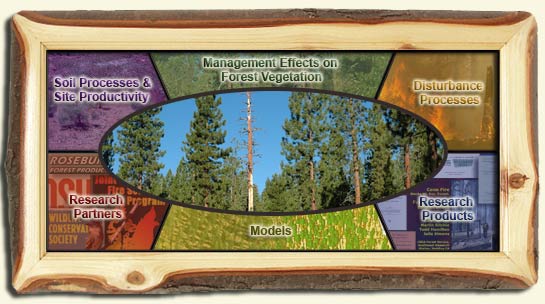|
Pacific Southwest Research Station
800 Buchanan Street
West Annex Building
Albany, CA 94710-0011
(510) 559-6300
|

|
|
 |
Programs and Projects
|
(RWU-4155)
|

|
Ecology and Management of Western Forests Influenced by Mediterranean Climate
|
|
 |
|
The mission of this unit is to develop concepts, information and predictive
models of the dynamic nature of western forests influenced by Mediterranean
climate and to determine effects of management strategies on forest productivity,
health, and sustainability. Four Science Teams and the Silviculture Development
Unit have been established to accomplish this mission.


|
 |
The Ecology and Management of Western Forests
Influenced by Mediterranean Climate with its primarly location
in Redding, California is a research program of the Pacific
Southwest Research Station, headquartered in Albany, California. The
unit and research station are part of the Forest Service, U.S. Department
of Agriculture.
![[image]: Research Pictures](https://webarchive.library.unt.edu/eot2008/20090514085803im_/http://www.fs.fed.us/psw/programs/ecology_of_western_forests/BMEFResearchsmall.jpg)
|
Research Teams
Soil Processes and Site Productivity
Management Impacts on Forest Vegetation
Disturbance Processes
Research Support
The silviculture development unit supports the activities at the Redding
Laboratory by assisting the implementation of research programs and technology
transfer efforts. Implementation includes treatment installation, maintenance,
monitoring, and measurement of results. 
Experimental Forests
Blacks Mountain Experimental Forest
Stanislaus - Tuolumne Experimental Forest
Swain Mountain Experimental Forest
Research Projects
Fire in Masticated Fuels Research Project
Mastication is an increasingly popular fuel modification technique involving the use of heavy machinery to shred standing live and dead shrubs and tree saplings into small chunks which are then dispersed on the forest floor as surface fuel. Research is being conducted to evaluate fire behavior when masticated fuels burn, develop custom fuel models for predicting fire behavior and effects, measure soil heating with burning at different soil moisture levels, and understand the vegetation response to mastication over time.
Cone Fire - Lessons for the Future
On September 26, 2002 the Cone fire ignited on the Hat Creek Ranger District of the Lassen National Forest, near the northeast corner of Black’s Mtn. Experimental Forest (BMEF). The fire burned portions of three of the twelve treatment units at BMEF with
variable intensities and completely burned the forestland located in between the
treatment units. It became apparent after the fire that the long-term study
treatments that came into contact with the fire, acted as fuel breaks of varying
degrees. From this incident, many lessons and research opportunities were created. Click the link to learn more.
Blacks Mountain Ecological Research Project
The Blacks Mountain experiment is a large-scale project designed to evaluate
the effects of stand structure, grazing and prescribed fire on various
components of the forest environment. Researchers are studying vegetation
response as well as the response of passerine birds, small mammals, bark
beetles to the treatments. |
|
Little Horse Peak (Goosenest AMA) Research Project
In the Goosenest Adaptive Management Area on the Klamath National Forest,
the combined effects of fire suppression and differential cutting of pine
have, over time, resulted in dense stands with a high proportion of white
fir. The buildup of fuels including dense white fir understories has caused
fire hazard to become so extreme that protection of remaining forest stands
with late-successional attributes is virtually impossible. While many wildlife
species have taken up residence in white fir infested pine forests, much
of the habitat potential has been altered. Silvicultural treatments have
the potential to accelerate development of late-successional attributes
but the ecosystem responses to these treatments are untested.
Fire & Fire Surrogates Study
Compared to historic conditions, many forests in the U.S. are now more
dense and have more down fuels. For years, managers have recognized this
problem and have acted to reduce stem density and fuels by thinning, burning,
and/or fuel treatments.
Growth and Yield Simulation (CONIFERS)
CONIFERS is a young stand simulator for southern Oregon and northwestern California.
Growth and Yield Simulation (SYSTUM-1)
SYSTUM-1 is a prototype simulator designed to simulate growth of young
plantations in northern California and southern Oregon (Ritchie and Powers
1993). |
|

![[image]: Research Pictures](https://webarchive.library.unt.edu/eot2008/20090514085803im_/http://www.fs.fed.us/psw/programs/ecology_of_western_forests/BMEFResearchsmall.jpg)